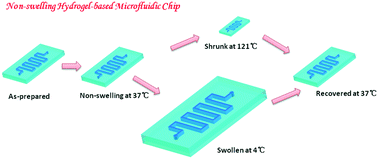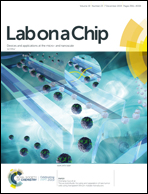Non-swelling hydrogel-based microfluidic chips†
Abstract
Hydrogel-based microfluidic chips are more biologically relevant than conventional polydimethylsiloxane (PDMS) chips, but the inherent swelling of hydrogels leads to a decrease in mechanical performance and deformation of the as-prepared structure in their manufacture and application processing. Non-swelling hydrogel has, for the first time, been utilized to construct microfluidic chips in this study. It was fabricated by covalently cross-linking the biocompatible copolymer of di-acrylated Pluronic F127 (F127-DA). Thanks to their non-swelling property, the hydrogel-based microfluidic chips maintain their as-prepared mechanical strength and channel morphology when equilibrated in aqueous solution at 37 °C. Moreover, the microfluidic chips are autoclavable and show an appropriately slow degradation rate by remaining stable within 21 days of incubation. Based on these properties, a vessel-on-a-chip was established by seeding human umbilical vein endothelial cells (HUVECs) onto the microchannel surfaces inside the microfluidic chip. Under 6 days of perfusion culture with a physiologically relevant shear stress of 5 dyne per cm2, the HUVECs in the chip show responsivity to fluid shear stress and express higher endothelial functions than the corresponding static culture. Therefore, non-swelling hydrogel-based microfluidic chips could potentially be applicable for cell/tissue-related applications, performing much better than conventional PDMS or existing hydrogel based microfluidic chips.



 Please wait while we load your content...
Please wait while we load your content...